Regulation of DCC localization by HTZ-1/H2A.Z and DPY-30 does not correlate with H3K4 methylation levels
- PMID: 21998734
- PMCID: PMC3187824
- DOI: 10.1371/journal.pone.0025973
Regulation of DCC localization by HTZ-1/H2A.Z and DPY-30 does not correlate with H3K4 methylation levels
Abstract
Dosage compensation is a specialized form of gene regulation that balances sex-chromosome linked gene expression between the sexes. In C. elegans, dosage compensation is achieved by the activity of the dosage compensation complex (DCC). The DCC binds along both X chromosomes in hermaphrodites to down-regulate gene expression by half, limiting X-linked gene products to levels produced in XO males. Sequence motifs enriched on the X chromosome play an important role in targeting the DCC to the X. However, these motifs are not strictly X-specific and therefore other factors, such as the chromatin environment of the X chromosome, are likely to aid in DCC targeting. Previously, we found that loss of HTZ-1 results in partial disruption of dosage compensation localization to the X chromosomes. We wanted to know whether other chromatin components coordinated with HTZ-1 to regulate DCC localization. One candidate is DPY-30, a protein known to play a role in DCC localization. DPY-30 homologs in yeast, flies, and mammals are highly conserved members of histone H3 lysine 4 (H3K4) methyltransferase Set1/MLL complexes. Therefore, we investigated the hypothesis that the dosage compensation function of DPY-30 involves H3K4 methylation. We found that in dpy-30 animals the DCC fails to stably bind chromatin. Interestingly, of all the C. elegans homologs of Set1/MLL complex subunits, only DPY-30 is required for stable DCC binding to chromatin. Additionally, loss of H3K4 methylation does not enhance DCC mislocalization in htz-1 animals. We conclude that DPY-30 and HTZ-1 have unique functions in DCC localization, both of which are largely independent of H3K4 methylation.
Conflict of interest statement
Figures
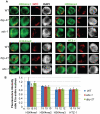

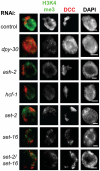
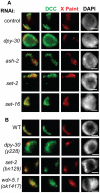
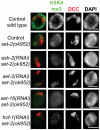
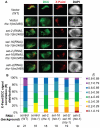

Similar articles
-
Restricting dosage compensation complex binding to the X chromosomes by H2A.Z/HTZ-1.PLoS Genet. 2009 Oct;5(10):e1000699. doi: 10.1371/journal.pgen.1000699. Epub 2009 Oct 23. PLoS Genet. 2009. PMID: 19851459 Free PMC article.
-
Condensin IDC, DPY-21, and CEC-4 maintain X chromosome repression in C. elegans.PLoS Genet. 2025 Apr 9;21(4):e1011247. doi: 10.1371/journal.pgen.1011247. eCollection 2025 Apr. PLoS Genet. 2025. PMID: 40203054 Free PMC article.
-
Developmental Dynamics of X-Chromosome Dosage Compensation by the DCC and H4K20me1 in C. elegans.PLoS Genet. 2015 Dec 7;11(12):e1005698. doi: 10.1371/journal.pgen.1005698. eCollection 2015 Dec. PLoS Genet. 2015. PMID: 26641248 Free PMC article.
-
X-Chromosome dosage compensation.WormBook. 2005 Jun 25:1-14. doi: 10.1895/wormbook.1.8.1. WormBook. 2005. PMID: 18050416 Free PMC article. Review.
-
C. elegans dosage compensation: a window into mechanisms of domain-scale gene regulation.Chromosome Res. 2009;17(2):215-27. doi: 10.1007/s10577-008-9011-0. Chromosome Res. 2009. PMID: 19308702 Review.
Cited by
-
Caenorhabditis elegans dosage compensation regulates histone H4 chromatin state on X chromosomes.Mol Cell Biol. 2012 May;32(9):1710-9. doi: 10.1128/MCB.06546-11. Epub 2012 Mar 5. Mol Cell Biol. 2012. PMID: 22393255 Free PMC article.
-
Linking dosage compensation and X chromosome nuclear organization in C. elegans.Nucleus. 2015;6(4):266-72. doi: 10.1080/19491034.2015.1059546. Epub 2015 Jun 9. Nucleus. 2015. PMID: 26055265 Free PMC article.
-
Differential spatial and structural organization of the X chromosome underlies dosage compensation in C. elegans.Genes Dev. 2014 Dec 1;28(23):2591-6. doi: 10.1101/gad.248864.114. Genes Dev. 2014. PMID: 25452271 Free PMC article.
-
The onset of C. elegans dosage compensation is linked to the loss of developmental plasticity.Dev Biol. 2014 Jan 15;385(2):279-90. doi: 10.1016/j.ydbio.2013.11.001. Epub 2013 Nov 16. Dev Biol. 2014. PMID: 24252776 Free PMC article.
-
A novel regulatory sex-skewing method that inhibits testicular DPY30 expression to increase female rate of dairy goat offspring.J Anim Sci. 2024 Jan 3;102:skad422. doi: 10.1093/jas/skad422. J Anim Sci. 2024. PMID: 38167777 Free PMC article.
References
-
- Ercan S, Lieb JD. C. elegans dosage compensation: a window into mechanisms of domain-scale gene regulation. Chromosome research : an international journal on the molecular, supramolecular and evolutionary aspects of chromosome biology. 2009;17:215–227. - PubMed
-
- Davis TL, Meyer BJ. SDC-3 coordinates the assembly of a dosage compensation complex on the nematode X chromosome. Development. 1997;124:1019–1031. - PubMed
Publication types
MeSH terms
Substances
Grants and funding
LinkOut - more resources
Full Text Sources
Molecular Biology Databases
Research Materials

